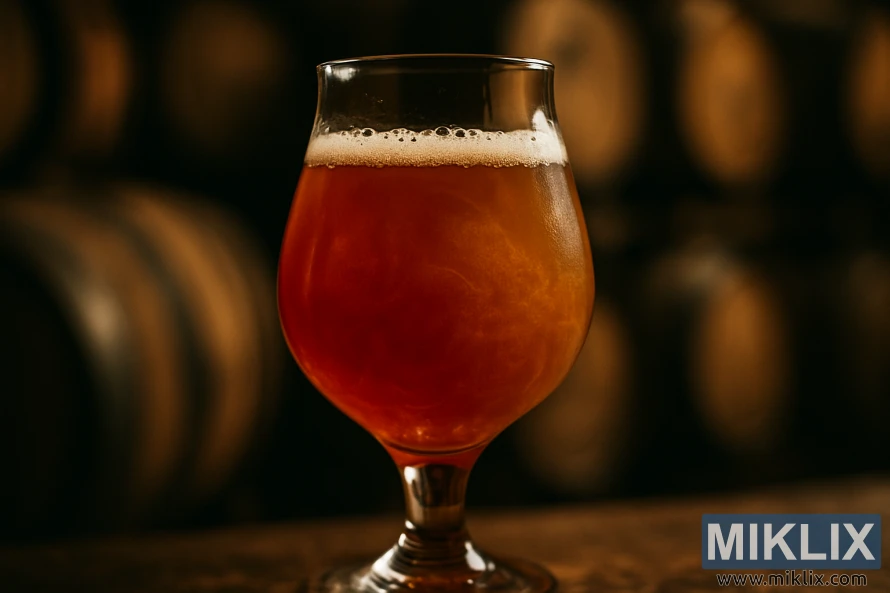Image: Hazy Amber Sour Ale in Tulip Glass
Published: September 12, 2025 at 2:50:31 PM UTC
A tulip glass holds hazy amber sour ale with a delicate foam ring, glowing warmly against a softly blurred backdrop of stacked wooden barrels.
A single tulip-shaped glass stands prominently at the center of the composition, dominating the frame in a striking medium close-up. The glass is broad at its bowl and tapers gently toward the rim before flaring outward slightly at the lip—a classic silhouette designed to capture and concentrate aromas. Within this vessel, a hazy, amber-colored liquid swirls languidly, suspended in soft motion as though it has just been gently rotated by hand. Wispy currents and faint, swirling eddies of darker ochre intermingle with glowing golden-orange highlights, giving the impression of depth and density. The liquid appears unfiltered, its haze lending it a rich, opaque character that suggests the presence of suspended yeast or fine particulates, typical of a traditionally crafted sour ale.
A thin, uneven cap of off-white foam rings the inner circumference of the glass just beneath the rim. The bubbles are small, delicate, and closely packed, clinging to the smooth inner surface of the glass like tiny beads of ivory. They glisten faintly, catching the ambient light in subtle specks. The foam has retreated from its initial fullness, leaving behind a faint lacing pattern that begins to trace down the side—evidence of the beer’s protein structure and a hint at its artisanal quality. The clarity of the glass reveals not only the beer’s visual complexity but also its weight and viscosity; it seems substantial yet effervescent, promising an intricate sensory experience.
Behind the glass stretches a softly blurred background composed primarily of large, rounded wooden barrels stacked in rows. Their staves are warm brown, their metal hoops a muted gray, and their surfaces gently illuminated by dappled, diffused light. The depth of field is shallow—so shallow that the barrels are rendered as a painterly wash of earthy tones, recognizable more by their curved shapes and color gradients than by any sharp details. This out-of-focus backdrop serves to frame the tulip glass without distraction, creating a sense of spatial depth and enveloping the scene in a rustic, cellar-like atmosphere. The play of light and shadow is subdued yet purposeful: gentle highlights graze the shoulders of the barrels and faintly glimmer across the tabletop surface, while deeper shadows pool between them, adding mystery and depth.
The lighting in the image is soft and diffuse, as if filtered through a thin veil or partially blocked by overhead slats. It casts a warm golden glow across the entire scene, intensifying the amber hue of the beer and creating subtle gradients along the curvature of the glass. This warm tone suffuses the image with an inviting intimacy, as if the viewer has stepped into a quiet, hidden barrel-aging room where time moves slowly. The glass itself is pristine, its contours outlined in fine specular highlights that shimmer gently along its edge. The reflection at the base stem gleams like polished crystal, grounding the composition with a sense of craftsmanship and care.
The overall mood is low-key, atmospheric, and contemplative. Every element—from the swirling haze in the beer to the blurred wooden barrels and the golden-toned lighting—works together to convey a feeling of artisanal authenticity and patient fermentation. The viewer can almost sense the complex aroma rising from the glass: tart cherries, lactic sharpness, earthy barnyard funk, and subtle whispers of oak. It is an image that celebrates nuance, tradition, and the quiet sophistication of a finely made sour ale, frozen in a single luminous moment.
The image is related to: Fermenting Beer with CellarScience Acid Yeast

